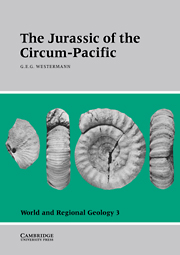Book contents
- Frontmatter
- Contents
- List of contributors
- Preface
- Acknowledgments
- Introduction
- Part I Time scales
- Part II Circum-Pacific base map
- Part III Regional geology and stratigraphy
- Part IV Biochronology
- 12 Ammonite zones of the circum-Pacific region
- 13 Jurassic palynomorphs of the circum-Pacific region
- 14 Radiolarian biozones of North America and Japan
- 15 Ostracods of western Canada
- 16 Bivalve zones and assemblages of the circum-Pacific region
- 17 Belemnites of the southwest Pacific
- Part V Biogeography
- Part VI Climatology and oceanography
- Appendix: Biochronology and atlas with index and guide fossils
- General Index
- Index of Guide- and Indexfossils
15 - Ostracods of western Canada
Published online by Cambridge University Press: 04 August 2010
- Frontmatter
- Contents
- List of contributors
- Preface
- Acknowledgments
- Introduction
- Part I Time scales
- Part II Circum-Pacific base map
- Part III Regional geology and stratigraphy
- Part IV Biochronology
- 12 Ammonite zones of the circum-Pacific region
- 13 Jurassic palynomorphs of the circum-Pacific region
- 14 Radiolarian biozones of North America and Japan
- 15 Ostracods of western Canada
- 16 Bivalve zones and assemblages of the circum-Pacific region
- 17 Belemnites of the southwest Pacific
- Part V Biogeography
- Part VI Climatology and oceanography
- Appendix: Biochronology and atlas with index and guide fossils
- General Index
- Index of Guide- and Indexfossils
Summary
Jurassic strata are well known from many boreholes throughout the southern prairie regions of western Canada, which, in Middle to Late Jurassic time, were part of the large intercratonic Williston Basin (see Figure 19.1, Chapter 19). Its relatively undisturbed sedimentary pile yields a varied and abundant microfauna on the basis of which a detailed biostratigraphic framework was constructed by Brooke and Braun (1972). This zonal scheme serves also as a template for correlations of Jurassic microfaunas recorded from other Western Interior regions of North America.
The exposures and the subsurface occurrences of Jurassic sequences in the Rocky Mountains to the west, the former miogeocline and Western Canada Basin, are geographically disjointed and tectonically disturbed. The rocks are by far not as fossiliferous, and the faunas not as varied and well preserved, as they are in the Williston Basin. They differ furthermore in overall composition and belong in part to a different faunal province and realm (see Chapter 19), adding measurably to the difficulties in correlation.
The biozones (assemblages, faunas), identified by Roman numerals, are based on all identifiable taxa of Ostracoda and Foraminifera recovered to date, with zonal boundaries chosen along marked breaks in the faunal spectrum. Appearances and/or disappearances of key species are used to denote the boundaries, with the assemblages providing substance to the zones. They are a mixture, therefore, of taxon range zones and assemblage zones following traditional micropaleontological practice.
- Type
- Chapter
- Information
- The Jurassic of the Circum-Pacific , pp. 296 - 299Publisher: Cambridge University PressPrint publication year: 1993

